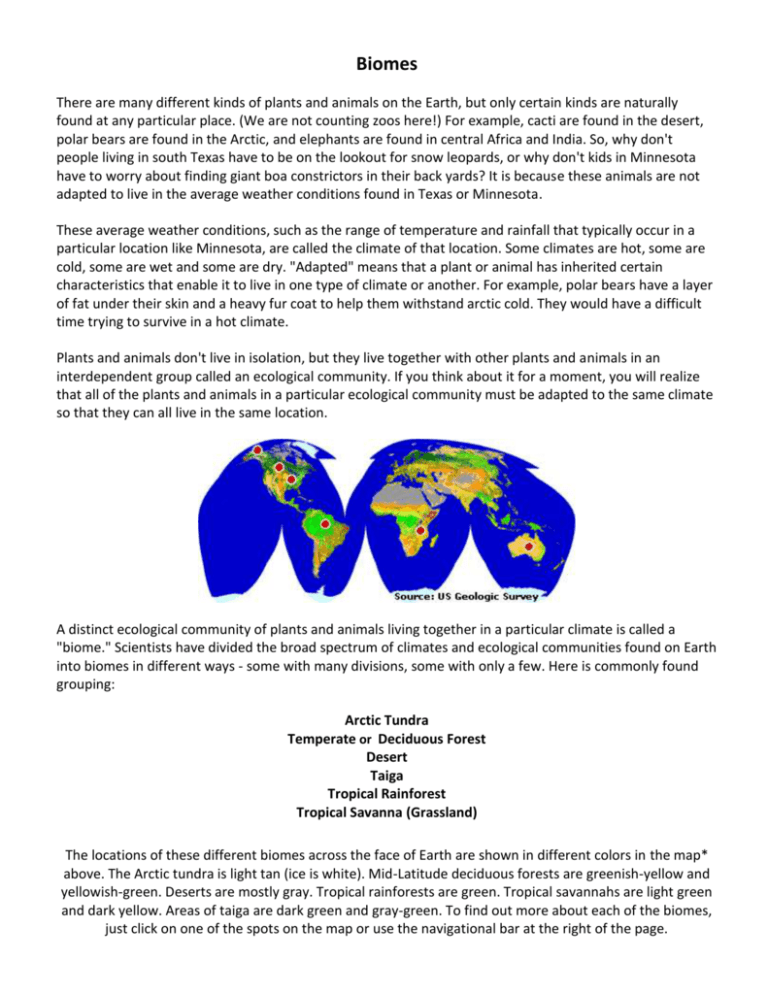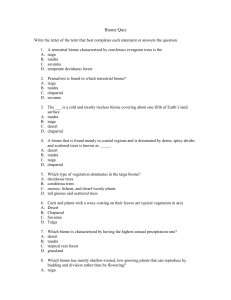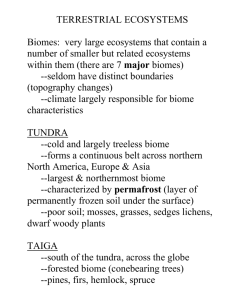Biomes Readings
advertisement

Biomes There are many different kinds of plants and animals on the Earth, but only certain kinds are naturally found at any particular place. (We are not counting zoos here!) For example, cacti are found in the desert, polar bears are found in the Arctic, and elephants are found in central Africa and India. So, why don't people living in south Texas have to be on the lookout for snow leopards, or why don't kids in Minnesota have to worry about finding giant boa constrictors in their back yards? It is because these animals are not adapted to live in the average weather conditions found in Texas or Minnesota. These average weather conditions, such as the range of temperature and rainfall that typically occur in a particular location like Minnesota, are called the climate of that location. Some climates are hot, some are cold, some are wet and some are dry. "Adapted" means that a plant or animal has inherited certain characteristics that enable it to live in one type of climate or another. For example, polar bears have a layer of fat under their skin and a heavy fur coat to help them withstand arctic cold. They would have a difficult time trying to survive in a hot climate. Plants and animals don't live in isolation, but they live together with other plants and animals in an interdependent group called an ecological community. If you think about it for a moment, you will realize that all of the plants and animals in a particular ecological community must be adapted to the same climate so that they can all live in the same location. A distinct ecological community of plants and animals living together in a particular climate is called a "biome." Scientists have divided the broad spectrum of climates and ecological communities found on Earth into biomes in different ways - some with many divisions, some with only a few. Here is commonly found grouping: Arctic Tundra Temperate or Deciduous Forest Desert Taiga Tropical Rainforest Tropical Savanna (Grassland) The locations of these different biomes across the face of Earth are shown in different colors in the map* above. The Arctic tundra is light tan (ice is white). Mid-Latitude deciduous forests are greenish-yellow and yellowish-green. Deserts are mostly gray. Tropical rainforests are green. Tropical savannahs are light green and dark yellow. Areas of taiga are dark green and gray-green. To find out more about each of the biomes, just click on one of the spots on the map or use the navigational bar at the right of the page. Biome Summary Arctic Tundra The tundra, which is commonly called the arctic tundra, is found across northern Alaska, Canada, and Siberia. This biome has long cold winters and short cool summers. The Arctic tundra has low precipitation (less than 10 inches per year) and dry winds. These conditions make the Arctic tundra a desert-like climate. One unique characteristic of the Arctic tundra is permafrost--ground that is permanently frozen. Because the permafrost has no cracks or pores, nothing can penetrate it--neither plant roots nor water. The surface layer above the permafrost thaws each summer. This layer is called the active layer. Thickness of the active layer depends on its location in the tundra. The more northerly the location, the thinner the active layer is. Curiously, during the summer Arctic tundra is characterized by lots of surface water. When snow melts, the water percolates through the active layer but is unable to penetrate the permafrost. Since the water has nowhere to go, the active layer becomes saturated and pools of water form on the surface. Another characteristic of the Arctic tundra is the limited amount of sunlight it receives due to the position of the Sun in the sky. Depending on the latitude, the Sun can remain below the horizon for up to 2 months, leaving the Arctic tundra in darkness. Although the sun remains in the sky 24 hours a day during the summer, it stays close to the horizon and provides only low intensity sunlight. Arctic Tundra: Animals Not many kinds of animals live year-round in the Arctic tundra. Most birds and mammals only use the tundra as a summer home. Mammals that do live year-round in the tundra include the muskox, Arctic wolf, and brown bear; and each has its own way of adapting to the extreme climatic conditions. Animals need to find ways to stay warm and to provide nourishment for themselves in order to survive the long, cold, winter months. Animal adaptations Migration and hibernation are examples of behavioral adaptations used by animals in the Arctic tundra. The fact that many animals do not live year-round in the tundra means they leave or migrate for a length of time to warmer climates. Hibernation is a combination of behavioral and physical adaptations. For example, during the summer the brown bear's behavior is to eat just about anything it can find; then it hibernates, or sleeps, during the winter. The bear's physical adaptation allows the food eaten during the summer to be stored as a layer of fat underneath its skin. The layer of fat insulates the bear from the cold. While in hibernation the fat is slowly converted into energy that maintains life. A physical adaptation used by the Musk Ox is the growth of two layers of fur--one short and the other long. Air is trapped in the short layer of fur and is warmed by body heat. The warmed air, trapped close to the body, acts as insulation from the cold. The layer of long fur protects the Musk Ox from the wind and water. In addition to thick layers of fur, the Musk Ox relies on another physical adaptation to help it survive. The hooves of the Musk Ox are large and hard. During the winter months, this adaptation allows the Musk Ox to break the ice and drink the water underneath. Arctic Tundra: Plants Plants need warmth and sunlight to grow and reproduce. In the Arctic tundra, warmth and sunlight are in short supply, even in the summer. The ground is frequently covered with snow until June, and the Sun is always low in the sky. Only plants with shallow root systems grow in the Arctic tundra because the permafrost prevents plants from sending their roots down past the active layer of soil. The active layer of soil is free from ice for only 50 to 90 days. Arctic plants have a very short growing season. However, in spite of the severe conditions and the short growing season, there are approximately 1,700 kinds of plants that live in the Arctic tundra. Some of the plants that live in the Arctic tundra include mosses, lichens, low-growing shrubs, and grasses--but no trees. In fact, "tundra" is a Finnish words which means "treeless". Plant Adaptations Growing close together and low to the ground are some of the adaptations that plants use to survive. This growing pattern helps the plant resist the effects of cold temperatures and reduce the damage caused by the impact of tiny particles of ice and snow that are driven by the dry winds. Plants also have adapted to the Arctic tundra by developing the ability to grow under a layer of snow, to carry out photosynthesis in extremely cold temperatures, and for flowering plants, to produce flowers quickly once summer begins. A small leaf structure is another physical adaptation that helps plants survive. Plants lose water through their leaf surface. By producing small leaves the plant is more able to retain the moisture it has stored. Temperate or Deciduous Forest The mid-latitude deciduous forest biome is located between the polar regions and the tropics. Because of its location, air masses from both the cold polar region and the warm tropical region contribute to the changes of climate in this biome. Mid-latitude deciduous forests have both a warm and a cold season (see climograph). Precipitation ranges from 30 to 60 inches and is evenly distributed throughout the year. Much of the human population lives in this biome. Although evergreens are found in this biome, this biome is characterized by an abundance of deciduous trees. "Deciduous" means to fall off, or shed, seasonally. Just as the name implies, these deciduous trees shed their leaves each fall. Lying on the forest floor, the leaves decay. As the leaves decompose, the nutrients contained in the leaves are absorbed by the soil. For this reason, the soils of this biome tend to be very fertile. Because this biome has fertile soil and a long, 5 to 6 month, growing season, many deciduous forests have been converted into agricultural regions. Deciduous Forest: Animals A wide variety of mammals, birds, insects, and reptiles can be found in a deciduous forest biome. Mammals that are commonly found in a deciduous forest include bears, raccoons, squirrels, skunks, wood mice, and, in the U.S., deer can be found in these forests. While bobcats, mountain lions, timberwolves, and coyotes are natural residents of these forests, they have nearly been eliminated by humans because of their threat to human life. Other animals that were native to this biome, such as elk and bison, have been hunted to near extinction. Animal Adaptations Migration and hibernation are two adaptations used by the animals in this biome. While a wide variety of birds migrate, many of the mammals hibernate during the cold winter months when food is in short supply. Another behavioral adaptation some animals have adopted is food storage. The nuts and seeds that are plentiful during the summer are gathered by squirrels, chipmunks, and some jays, and are stored in the hollows of trees for use during the winter months. Cold temperatures help prevent the decomposition of the nuts and seeds. Deciduous Forest: Plants Trees of this biome include both broadleaf, deciduous trees, such as maple, oak, hickory, and beech, and evergreens, such as hemlock, spruce, and fir. A deciduous forest typically has three to four, and sometimes five, layers of plant growth. Tall deciduous trees make up the top layer of plant growth, and they create a moderately dense forest canopy. Although the canopy is moderately dense, it does allow sunlight to reach the forest floor. This sunlight allows plants in the other layers to grow. The second layer of plant growth includes saplings and species of trees that are naturally shorter in stature. A third layer (or understory) would include shrubs. Forest herbs, such as wildflowers and berries, make up a fourth layer. During the spring, before the deciduous trees leaf out, these herbs bloom and grow quickly in order to take advantage of the sunlight. A fifth layer would include mosses and lichens that grow on tree trunks. Plant adaptations In the spring, deciduous trees begin producing thin, broad, light-weight leaves. This type of leaf structure easily captures the sunlight needed for food production (photosynthesis). The broad leaves are great when temperatures are warm and there is plenty of sunlight. However, when temperatures are cold, the broad leaves expose too much surface area to water loss and tissue damage. To help prevent this damage from occurring, deciduous trees make internal and physical adaptations that are triggered by changes in the climate. Cooler temperatures and limited sunlight are two climatic conditions that tell the tree to begin adapting. In the Fall, when these conditions occur, the tree cuts off the supply of water to the leaves and seals off the area between the leaf stem and the tree trunk. With limited sunlight and water, the leaf is unable to continue producing chlorophyll, the "green" stuff in the leaves and as the chlorophyll decreases, the leaves change color. The beautiful display of brilliant red, yellow, and gold leaves, associated with deciduous forests in the fall, is a result of this process. Most deciduous trees shed their leaves, once the leaves are brown and dry. Desert The defining characteristic of a desert is that it is dry. Depending on its geographical location, the annual precipitation in a desert varies from half an inch to as much as 15 inches. Rainfall is usually very localized, and although it is frequently seasonal, it is difficult to predict when or where it will occur. At times in the Atacama Desert in Chile, years have passed with no measurable rainfall at all. However, that is not generally the case. Deserts can be either hot such as the Australian Desert or cold such as the Gobi Desert. As with all biomes, the desert climate is determined by geographic conditions. Geographic conditions such as location, high atmospheric pressure, and proximity of mountain ranges determine just what type of desert it is. Deserts may occur along the coast such as the Atacama and Namib deserts or in the interior of continents such as the Great Basin and Australian deserts, which are far from any source of water. Coastal deserts are located on west coasts of continents between 20° to 30° latitude. Prevailing winds blow in an easterly pattern and prevent the moisture from moving onto the land. Semiarid deserts, like the Great Basin Desert, are not only located far from moisture, but are frequently associated with high mountain ranges that produce a rainshadow effect. The rainshadow effect prevents available moisture from reaching the area. The great Gobi Desert of Mongolia has little rainfall because the Himalayan Mountains prevent rainfall from moving into this region. Because all deserts are dry, they have large daily temperature variations. Temperatures are high during the day because there is very little moisture in the air to block the Sun's rays from reaching Earth. Once the Sun goes down, the heat absorbed during the day quickly escapes back into space. High daytime temperatures and low nighttime temperatures make survival in the desert very difficult. Desert: Animals At first glance, deserts may appear to be without animal life. However, deserts are home to many reptiles, insects, birds, and small mammals. The kangaroo mice of North America and the bilby and red kangaroo of Australia are just a few examples of small mammals that live in the desert. Most large animals have not adapted to desert life. Their size prevents them from finding shelter from the Sun's heat and they are not able to store water for future use. Animals that do survive in the desert have developed a number of adaptations. Animal adaptations The most universal behavioral adaptation used by small mammals, reptiles, and insects to deal with high temperatures is staying in the shadow (shade) of plants or rocks, thus avoiding the direct rays of the Sun. These animals also seek shelter by burrowing into the ground. Just as a basement room is cooler than an above-ground room, a burrow, even a few feet underground, can decrease the temperature by several degrees. Another behavioral adaptation used by desert animals is to remain inactive during the hot daylight hours. They hunt at night when temperatures are cool and when there is less risk of losing precious body water. Animals that use this adaptation are referred to as nocturnal. Some animals get all of the water they need from the insects, bulbs, and seeds they eat. They will not drink water even when it is available. Some animals have developed salt glands, a physical adaptation that allows the secretion of salt without the loss of water. The absence of sweat glands and the concentration of urine are other physical adaptations made by desert animals. Because fat intensifies heat, a unique physical adaptation of some desert animals is the storage of fat in humps or tails, rather than throughout the entire body. Desert: Plants Short grasses, sagebrush, creosote bushes, and cacti are just a few of the plants that can be found in the desert. Plant abundance and variety are determined by the geographic location of the desert. Although short grasses can be found in nearly all desert locations, the saguaro cactus is unique to the Sonoran Desert, and the spiniflex is associated with the Australian Desert. Plant adaptations Because of the dry climate, plants have developed a number of different methods of capturing water. Some plants have developed long (20-30 foot) taproots that go deep into the ground and tap into groundwater sources. Other plants have developed extensive horizontal root systems. These horizontal root systems lie just below the surface and extend far beyond the plant canopy. When it rains the numerous tiny roots capture the water. The mulga tree's root system lies close to the base of the tree. The tree survives because it has developed its own unique system of collecting water. The tree's numerous tiny leaves grow upward. When it rains the leaves capture the water and funnel it down along the branches to the center of the tree. The water then falls to the ground near the trunk of the tree where tree roots are concentrated. Another common physical adaptation is the ability of desert plants to store water in their roots, stems, leaves, or fruit. Plants that store water in this way are referred to as succulents, and they include cacti. Desert plants retain moisture by limiting water loss through their leaf surface. Many plants accomplish this by adapting the size, sheen, or texture of their leaves. Small leaves or spines limit the amount of surface area exposed to the drying heat. Glossy leaves reflect the Sun's radiant heat reducing leaf temperatures and evaporation rates. Waxy leaves prevent moisture from escaping. Water escapes from leaves through the stomata, or leaf pores. A behavioral adaptation used by some plants is to only open leaf pores during the night when air temperature is cool and evaporation rate is low. Taiga The taiga biome is found in the northern hemisphere close to the polar region. This cold biome (see climograph) stretches across the northern portions of North America, Europe, and Asia. Large population centers, such as Moscow and Toronto, can be found in the southern portion of this biome, but the northern portion is relatively unpopulated. Within this biome, there is a wide range of temperatures between winter and summer seasons. Winters are long and cold, and the summers are short and cool. Precipitation is moderately high throughout the year with snow occurring during the winter months. Most of the taiga in North America was once covered with glaciers that have receded, leaving gouges and depressions in the topography. Since there is moderately high precipitation, these gouges and depressions are frequently filled with water, creating bogs and lakes. The soil found in the taiga is low in nutrients and high in acid. It also is rocky and covered with un-decayed leaf litter. Patches of permafrost can also be found in areas of the taiga. Taiga: Animals The cold climate of the taiga prevents many animals from living there year-round. Some of the large animals found in the taiga include moose, deer, and bears. Examples of smaller animals that live in the taiga are bobcats, squirrels, chipmunks, ermine, and moles. The taiga is home to many insects and birds such as the bald eagle, chickadee, woodpeckers, and warblers. The bogs and ponds, found throughout the taiga during the summer, provide a wonderful breeding place for a wide variety of insects. Many migratory birds come to the taiga to nest and feed on the huge insect population. Animal adaptations Most animals migrate to warmer climates once the cold weather begins. Some animals have adapted to life in the taiga by hibernating when temperatures drop. Other animals have adapted to the extreme cold temperatures by producing a layer of insulating feathers or fur to protect them from the cold. In some instances, the adaptation of a seasonal change in color of feathers or fur protects the animal from its predators. The ermine, a small mammal, is a good example of this adaptation. Its dark brown summer coat changes to white in the winter. This adaptation helps the ermine blend into its surroundings and makes it more difficult for the ermine's predators to spot them. Taiga: Plants Because the climate of the taiga is very cold, there is not a large variety of plant life. The most common type of tree found in the taiga is the conifer--trees that have cones. Four kinds of conifers are common in the taiga. Three of the common conifers are evergreens; spruce, fir, and pine. The fourth common conifer is the tamarack, or larch, a deciduous tree. Under certain conditions, broadleaf trees, such as birch and aspen, are able to survive the harsh climate of the taiga. Plant adaptations Evergreens use a wide variety of physical adaptations. Some of these adaptations include their shape, leaf type, root system, and color. Their name, evergreen, describes an important adaptation. They are always-or ever green. Because they don't drop their leaves when temperatures cool, they don't have to re-grow them in the spring. Growing new leaves takes a lot of energy. Plants get their energy from the soil and from the Sun. Soil is a source of nutrients. Sunlight is necessary for photosynthesis to take place in the plant. The taiga soil doesn't contain many nutrients, and the Sun usually remains low in the sky. These two factors limit the amount of energy available to the tree. By keeping their leaves, the evergreens are able to use that limited energy for structural growth rather than producing leaves. Although the taiga has moderately high precipitation, the ground freezes during the winter months and plant roots are unable to get water. The adaptation from broadleaf to narrow needle-like structures limits water loss through transpiration. Evergreen needles do not contain very much sap. This limits the risk of needle damage from freezing temperatures. The needles do, however, contain a chemical that repels animals that would eat the needles. The dark green color of the needles absorbs the sunlight, and since the needles are always present, once temperature start to get warm, photosynthesis quickly begins. The conical shape of the evergreens allows the snow to slide off the branches rather than pile up. If the snow can't pile up on the branches, there is less risk of broken branches due to the weight of the snow. Tropical Rainforest The tropical rainforest is a hot, moist biome found near Earth's equator. The world's largest tropical rainforests are in South America, Africa, and Southeast Asia. Tropical rainforests receive from 60 to 160 inches of precipitation that is fairly evenly distributed throughout the year. The combination of constant warmth and abundant moisture makes the tropical rainforest a suitable environment for many plants and animals. Tropical rainforests contain the greatest biodiversity in the world. Over 15 million species of plants and animals live within this biome. The hot and humid conditions make tropical rainforests an ideal environment for bacteria and other microorganisms. Because these organisms remain active throughout the year, they quickly decompose matter on the forest floor. In other biomes, such as the deciduous forest, the decomposition of leaf litter adds nutrients to the soil. But in the tropical rainforest, plants grow so fast that they rapidly consume the nutrients from the decomposed leaf litter. As a result, most of the nutrients are contained in the trees and other plants rather than in the soil. Most nutrients that are absorbed into the soil are leached out by the abundant rainfall, which leaves the soil infertile and acidic. Tropical Rainforest: Animals Tropical rainforests support a greater number and variety of animals than any other biome. One of the reasons for this great variety of animals is the constant warmth. Tropical rainforests also provide a nearly constant supply of water and a wide variety of food for the animals. Small animals, including monkeys, birds, snakes, rodents, frogs, and lizards are common in the tropical rainforest. Many of these animals and a multitude of insects never set foot on the ground. The animals use the tall trees and understory for shelter, hiding places from their predators, and a source of food. Animal adaptation Because there are so many animals competing for food, many animals have adapted by learning to eat a particular food eaten by no other animal. Toucans have adapted by developing long, large bill. This adaptation allows this bird to reach fruit on branches that are too small to support the bird's weight. The bill also is used to cut the fruit from the tree. The sloth uses a behavioral adaptation and camouflage to survive in the rainforest. It moves very, very slowly and spends most of its time hanging upside down from trees. Blue-green algae grows on its fur giving the sloth a greenish color and making it more difficult for predators to spot. Tropical Rainforest: Plants Although tropical rainforests receive 12 hours of sunlight daily, less than 2% of that sunlight ever reaches the ground. The tropical rainforest has dense vegetation, often forming three different layers--the canopy, the understory, and the ground layer. Frequently, people think of the tropical rainforest as a "jungle" where plant growth is dense even at ground level. However, the canopy created by the tall trees (100-120 feet) and the understory, prevents sunlight from reaching the ground. The soil is, therefore, always shaded, and very little vegetation is able to survive at ground level. Vegetation can become dense at ground level near riverbanks and on hillsides. Hillsides have more plant growth because the angle of the growing surface allows sunlight to reach lower layers of the forest. Riverbeds break up the forest canopy so that smaller plants can get the needed sunlight. Plant adaptation Plant survival in a tropical rainforest depends on the plant's ability to tolerate constant shade or to adapt strategies to reach sunlight. Fungus is a good example of a plant that flourishes in warm, dark places created by the forest canopy and understory. Competition for sunlight by plants is sometimes deadly. The strangler fig needs sunlight to grow and reproduce. Seeds falling to the ground quickly die in the deep shade and infertile soil of the tropical rainforest. So it has adapted. Its seeds are deposited on branches of host trees by birds and small animals that have eaten the fruit of the strangler fig. The seeds sprout and send a long root to the ground. This root rapidly increases in diameter and successfully competes for the water and nutrients in the soil. As the strangler fig matures, branches and leaves grow upwards creating a canopy that blocks sunlight from the host tree. Additional roots are sent out and wrap around the host tree, forming a massive network of roots that strangle and eventually kill the host. Tropical Savanna (Grassland) The tropical savanna, which is a type of grassland, is a biome characterized by tall grasses and occasional trees. Large regions of tropical savanna extend through the nations of Botswana, Namibia, and Kenya in Africa, southern Brazil, India, and Australia. Surprisingly, the Everglades of southern Florida in North America is also a tropical savanna. Savannas exist in areas where there is a 6 to 8 month wet summer season and a dry winter season. Annual rainfall in savannas varies depending on the geographic location. Some savannas get as little as 10 inches of rain annually while others can get as much as 50 inches. The dry season is marked by months of drought and fire which are essential to the maintenance of savannas. Without the period of drought and fire, some scientists believe that tropical savannas would eventually change into tropical forests. Savannas can result from climate, soil conditions, animal behavior, or agricultural practices, which limit the occurrence of trees. Humans create savannas by burning the grasslands and felling the trees in order to plant crops. Large animals such as elephants can turn a forest into a savanna by stripping the bark from the trees, knocking over trees, and tramping on tree seedlings. Tropical Savanna: Animals The species of animals in a savanna depends upon the geographic location of the biome. The African savanna, the savanna with which most people are familiar, is home to a wide variety of animals. A short list of some of those animals includes wildebeest, warthogs, elephants, zebras, rhinos, gazelles, hyenas, cheetahs, lions, leopards, ostrich, mouse-birds, starlings, and weavers. Animal adaptations During the rainy season, birds, insects, and both large and small mammals thrive in the savanna, but the rainy season only lasts 6 to 8 months. During the dry season, surface water from the rain is quickly absorbed into the ground because the soil is extremely porous. Competition for water during the dry season is intense. Consequently, most birds and many of the large mammals migrate during the dry season in search of water. Because drought conditions are sometimes localized, the migration may be just to another area within the savanna. When drought conditions exist for a long time and over a wide area, the animals may migrate to another biome until the rainy season begins again. Although elephants do migrate, they have a physical adaptation that allows them to access water that is not available to other animals. Baobab trees store water in their large trunks. The elephant's physical strength and anatomy allow it to tear open the trunk of the baobab tree and to suck the water from it. An adaptation used by small burrowing animals is to remain dormant during times of drought--much like bears do during the winter in other biomes. During the dry season, lightning frequently ignites the brown, dry grasses that cover the savanna. Many of the animals have adapted to living with the fires. The ability to fly or to run fast enables most birds and large mammals to escape the flames. Some birds, such as the Fork-tailed Drongos, actually are attracted to the active fires. These birds feast on fleeing or flame-roasted insects. Although small burrowing animals may not be able to outrun the flames, they frequently survive the fire by digging beneath the soil and remaining there until the flames pass by them. Tropical Savanna: Plants Grasses are the dominant plant life in the savanna. A wide variety of grasses grow in savannas, but different varieties are found in different savannas. Some grasses grow 6 to 9 feet tall. Trees growing alone or in small clusters are also part of the savanna biome. In fact, without the trees, the savanna biome would be considered a prairie. The variety of trees in a particular savanna is dependent upon the geographic location of the savanna. The acacia and baobab trees are common in African savannas. Plant adaptations In order for the grasses to survive the dry season and the periodic fires, they have developed an adaptation that allows them to grow quickly when there is adequate water. Then when water becomes scarce, the grasses turn brown to limit water loss. They store necessary moisture and nutrients in their roots while they await the return of the rainy season. With food and water reserves stored below ground, the grasses are able to survive the effects of fire as well. In fact, fire stimulates new growth and replenishes the soil with nutrients. The baobab tree has adapted to the savanna biome by only producing leaves during the wet season. When leaves do grow, they are in tiny finger-like clusters. The small size of the leaves helps limit water loss. Another adaptation that enables the baobab tree to survive the long months of drought is its ability to store water in its large trunk. The acacia tree can survive drought conditions because it has developed long tap roots that can reach deep, ground water sources. It is also fire resistant. Some varieties re-sprout from the root crown when the above ground portion of the tree is damaged by fire. Fire is not the only hazard faced by the acacia tree. The acacia tree has developed very useful physical and behavioral adaptations to discourage animals from eating its leaves. It developed long, sharp thorns and a symbiotic relationship with stinging ants. The ants live in acacia thorns they have hollowed out, and they feed on the nectar produced by the tree. When an animal takes a bite of leaves (and thorns), it also gets a mouthful of angry, stinging ants. The ants defend their homes from other insects as well, thus protecting the acacia tree. Giraffes graze on the tops of the acacia, which results in the domeshaped top characteristic of Acadia trees. A behavioral adaptation aimed at preventing giraffe grazing is a chemical defense system that is triggered when the giraffe begins to munch on the leaves. First, a poisonous alkaloid that tastes nasty is pumped into the leaves. The giraffe only gets a couple of mouthfuls of leaves before the remaining leaves become inedible. Then, the tree warns other acacia trees in the area by emitting a chemical into the air. The other acacia trees respond by pumping alkaloid into their leaves. Assigned Biome: _________________________________ Name: ______________________ Basic Characteristics of your Biome Animal Adaptations Plant Adaptations Summary:







